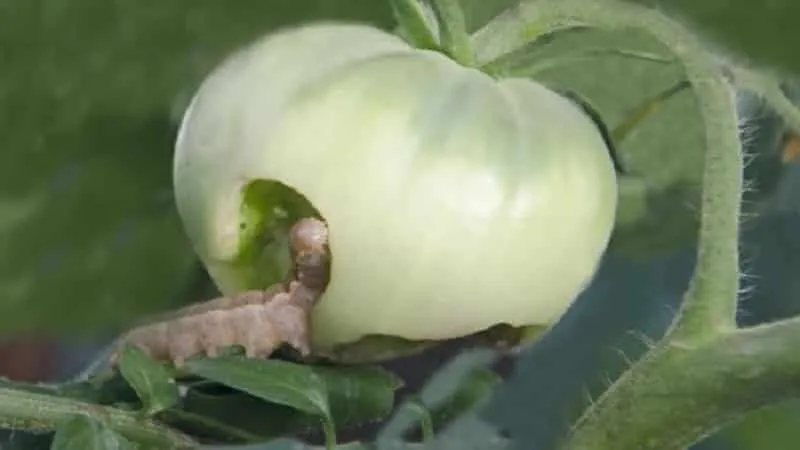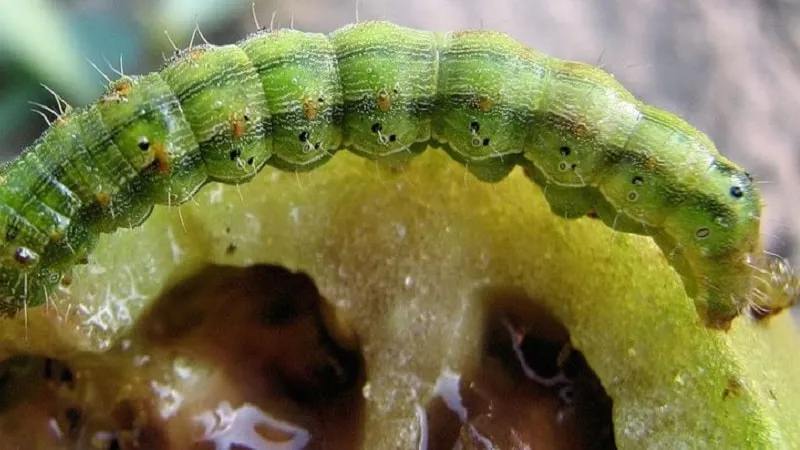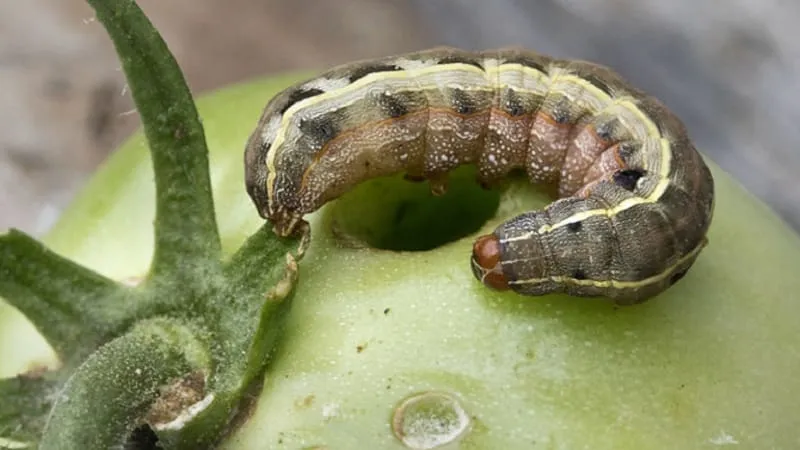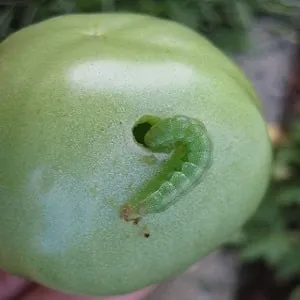Tomato plants being destroyed by caterpillars is a problem familiar to many gardeners. The tomato moth (also known as the tomato fruitworm) is the most common culprit, with peak activity occurring in mid-summer. In just 20 days of the caterpillar stage, this pest can leave farmers without a harvest.
Preventing moth infestations begins with proactive measures. If plants become infested, growers turn to "heavy artillery" — contact-intestinal insecticides. Alongside these, home remedies and entomophages (microscopic insects) are used. These methods are equally effective at eliminating pests while allowing for organic produce.
How should you treat caterpillars on greenhouse tomatoes? Which products are most effective? This article provides detailed answers to these questions and more.
Table of contents
Caterpillars on Tomatoes and Signs of Infestation
The appearance of unremarkable moths resembling large nocturnal butterflies on tomato plants in early summer should raise immediate concern. While adult moths are harmless — feeding only on nectar and laying eggs — their larvae (caterpillars) cause significant damage.
Tomato moths are highly prolific. A single female can lay 500 to 1,000 eggs per season. In warm weather, eggs hatch in 5 days; in cooler conditions, this takes up to 10 days.

The caterpillar development stage lasts 20 days. During this time, they chew through stems, leaves, and tomato fruits. After feeding, caterpillars burrow into the soil, pupate, and overwinter until the next season.
The tomato moth has a wingspan of up to 3.5 cm. Its forewings are gray-brown, while the hindwings have a pinkish hue with zigzag patterns and stripes.
Caterpillar characteristics:
- Large body — 2.5–3 cm long;
- Color varies from green to brown;
- Thin longitudinal stripes with fine hairs on the back;
- Dark, wide stripes along the sides with thinner yellow lines beneath;
- Light-colored abdomen with white speckles.
These pests are nocturnal: caterpillars chew holes in foliage and fruits at night, then hide underground (up to 5 cm deep) by dawn.
Causes of Infestation
Primary reasons for tomato moth infestations:
- Inadequate post-harvest soil treatment;
- Failure to follow crop rotation principles;
- Poor agricultural practices (lack of weeding, insufficient soil aeration);
- Using ineffective pest control methods during active seasons (surviving caterpillars overwinter in the soil).
Primary Control Methods
Effective strategies against tomato moths include:
- Manual caterpillar removal;
- Chemical treatments;
- Home remedies;
- Biological control.

Chemical Treatments
How to eliminate green caterpillars on greenhouse tomatoes? Chemical insecticides are the most effective solution. Spraying should be timed carefully, as pesticides take 20–30 days to dissipate from fruits. Always calculate the pre-harvest interval (PHI) before application.
Warning! Wear gloves and a respirator when handling chemicals.
Recommended European-approved insecticides:
- Decis ProTech — A fast-acting contact-intestinal insecticide containing deltamethrin. Moderately hazardous to humans. Use 0.5 g per 5 L water for 100 m². Apply before flowering; protection lasts 10–15 days.
- Mavrik — A low-toxicity insecticide with tau-fluvalinate. Effective against eggs and caterpillars. Use 200–300 mL per hectare during vegetative growth (max 2 applications).
- SpinTor — A natural spinosad-based insecticide. Rainfast and organic-certified. Dilute 4 mL per 10 L water for spraying or soil drenching.
- Karate Zeon — A lambda-cyhalothrin formula with low environmental persistence. Apply 240–320 mL per hectare once during vegetation.
- Calypso — A systemic thiacloprid insecticide. Provides 30-day protection. Compatible with biofungicides. Use 5 mL per 10 L water for foliar spray.
- NeemAzal — An azadirachtin-based botanical insecticide. Apply twice per growth cycle (1 mL per 10 L water). Greenhouse protection: up to 20 days.
Important! Rotate chemical classes annually — tomato moths rapidly develop resistance. Last season’s solution may fail this year.
Home Remedies
Home solutions work best at early infestation stages. They’re ineffective against large outbreaks.
Proven recipes:
- Steep crushed garlic scapes (or 1 bulb) in 1 L hot water for 3–4 days. Dilute to 10 L and spray biweekly.
- Mix 300 g tobacco dust with 10 L boiling water; steep 24 hours. Apply fortnightly.
- Fill a zinc barrel with chopped wild cherry leaves, add boiling water, and steep 24 hours. Use for foliar/soil treatment.
- Boil 1 kg fresh wormwood in 3 L water for 30 minutes. Dilute to 10 L; spray every 2 weeks.
- Ferment burdock, chamomile, yarrow, or potato tops in 10 L water for 4 days. Spray every 14 days.
Add 30–50 g grated soap (bar or tar) per 10 L solution.

Saltwater solution: Dissolve 2 tbsp rock salt in 10 L water; drench plants thoroughly.
Biological Controls
What if caterpillars devour greenhouse tomatoes? Employ their natural enemies. Trichogramma wasps parasitize moth eggs — infected eggs blacken within 2–3 days. Release twice per season.
Braconid wasps (Microplitis) are lethal to caterpillars. Females inject toxins that disrupt digestion.
Note: Entomophages guarantee organic compliance. Ideal for commercial tomato operations.
Preventive Measures
Key prevention strategies:
 Deep-plow soil in autumn (exposes pupae to freezing temperatures);
Deep-plow soil in autumn (exposes pupae to freezing temperatures);- Practice winter soil flooding;
- Remove all plant debris (including roots);
- Replace top 15 cm greenhouse soil annually;
- Sterilize planting sites with boiling water or potassium permanganate;
- Weed meticulously;
- Prune lower leaves and improve airflow;
- Water at soil level (morning only);
- Install insect nets on greenhouse vents/doors;
- Apply preventive home sprays routinely.
Plants That Repel Moths
Interplant tomatoes with celery — its scent deters egg-laying moths. Other repellents: coriander, white mustard, marigolds, basil, thyme, sage, geraniums, or wormwood.
Conclusion
Unfortunately, many growers recognize tomato moth infestations too late for prevention. Chemical treatments then become necessary — but require 20–30 day pre-harvest intervals, and resistance develops quickly.
Home remedies support organic production yet falter against severe infestations. Entomophages offer eco-friendly mass control, ideal for commercial growers.
The optimal strategy combines vigilance (plant inspections), soil management (sterilization, crop rotation), and strict agricultural protocols.







